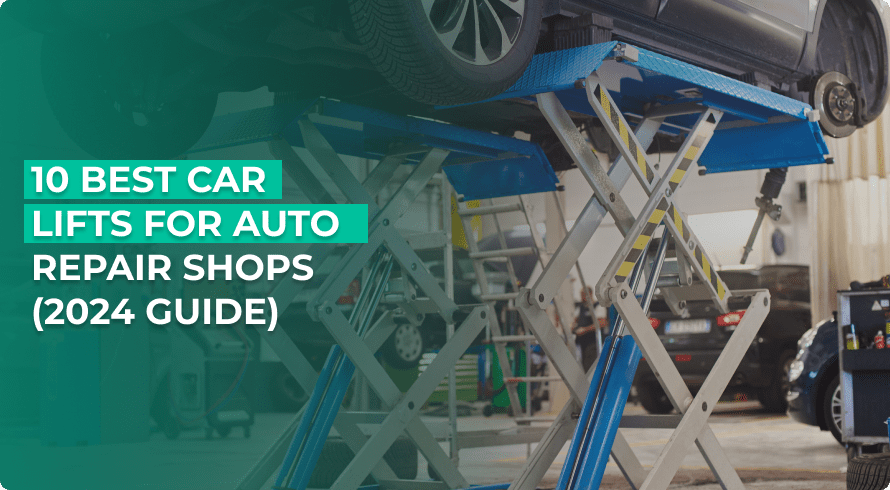Are you ready to install a new car lift in your auto repair shop? You came to the right place!
In this blog post, we will review different car lifts and the specific role they can play in your auto repair business. Without further ado, let’s get into our top 10 recommendations.
Unlock powerful tools to manage your shop. Get the full AutoLeap experience today.
Top 10 car lifts for your auto repair shop
1. BendPak® XPR-10AS (two-post car lift)
Known for its sturdy construction and ease of use, the BendPak® XPR-10AS is a popular choice in auto repair shops. This popular BendPak lift® offers a lifting capacity of up to 10,000 lbs and features automatic safety locks.
- Durability and build quality: This lift is built with sturdy materials and designed to withstand the demands of a busy shop.
- Lifting capacity: The XPR-10AS has a substantial lifting capacity, supporting around 10,000 pounds.
- Versatility: The lift features adjustable arms and a versatile design for easy positioning.
- Safety features: The XPR-10AS includes safety features such as automatic safety locks and durable lifting cables.
- Installation and space requirements: Installing a two-post lift will require some patience.
- Initial cost: The upfront price tag may not work for your shop’s budget.
- Less stability for certain tasks: They might offer slightly less stability than four-post lifts for performing wheel alignments.
- Regular maintenance: Like any mechanical equipment, car lifts require regular maintenance to ensure they function safely.
2. Rotary® SPOA10 (two-post car lift)
Rotary® Lift is a trusted name in the industry, and its SPOA10 model is no exception. This lift is known for its smooth operation, adaptability to various vehicle sizes, and impressive durability.
- Durability and reputation: The SPOA10 has a durable design made with quality engineering.
- Lifting capacity: It has a lifting capacity of around 10,000 pounds.
- Clear undercarriage access: This popular lift gives your techs excellent access to the undercarriage.
- Versatility: The lift features adjustable arms and a versatile design. It is flexible to position and accommodate different vehicle sizes and configurations.
- Installation and space requirements: Adequate ceiling height is essential to accommodate raised vehicles.
- Initial cost: Quality automotive lifts like the Rotary® Lift SPOA10 can have a significant upfront cost.
- Stability for certain tasks: It might offer slightly less stability than four-post lifts, particularly for wheel alignments.
- Regular maintenance: They require routine inspections, lubrication, and addressing any issues promptly.
3. Challenger 4P14EFX (four-post car lift)
The Challenger 4P14EFX features a 14,000 lbs lifting capacity, making it suitable for heavier vehicles. This quality option in the Challenger Lifts lineup features adjustable runways support for wheel alignments, with an adjustable design for long-term storage as needed.
- Versatility: Your technicians can use four-post car lifts like the Challenger 4P14EFX for many repairs.
- Ease of use: This lift is relatively easy to use and requires minimal training.
- Wheel alignment: This lift is suitable for shops offering alignment services.
- Space requirements: Four-post car lifts take up significant space in your shop.
- Installation: You may need help with professional installation, which can add to the overall cost.
- Limited access: Four-post lifts can obstruct access to the undercarriage.
- Cost: This lift may be too significant of an investment for some businesses.
4. BendPak® MD-6XP (scissor car lift)
The BendPak® MD-6XP is a compact, portable scissor lift. This lift is perfect for smaller auto repair shops. Despite its size, it can lift 6,000 lbs and provides an impressive lifting height.
- Space efficiency: The BendPak® MD-6XP is highly regarded for its compact design.
- Access to vehicle undercarriage: The access makes several maintenance and repair tasks more convenient.
- Ease of use: These lifts are generally easy to use and operate.
- Portability: You can move this lift around your shop without trouble.
- Limited height: Scissor lifts generally have a lower maximum lift height than other lift types.
- Access to wheels: They might not provide the same level of wheel access as some other lifts.
- Installation: Professional installation might be required.
- Floor requirements: Scissor lifts require a level concrete floor for proper installation and operation.
5. MaxJax® (two-post car lift)
MaxJax® is a tremendous portable two-post car lift for shops with space constraints. It’s capable of supporting up to 7,000 pounds. It’s a portable two-post lift with a 6,000-pound lifting capacity.
- Portability: The MaxJax® is easy to transfer around your shop.
- Space efficiency: This lift’s compact design requires less floor space.
- Vehicle accessibility: The two-post design allows for excellent access to the undercarriage.
- Weight capacity: The MaxJax® delivers a reasonable weight capacity, suitable for many cars and light trucks.
- Lift height: The height might be more limited compared to traditional two-post lifts.
- Weight limitation: While suitable for many vehicles, the weight capacity of the MaxJax® might not be sufficient for larger trucks or SUVs.
- Arm reach: The arms of the MaxJax® may have a more limited reach than you require.
- Stability: Follow safety guidelines and procedures to ensure safe operation.
6. Hunter Engineering RX16 (scissor car lift)
The RX16, designed by Hunter Engineering Company, is designed for wheel alignments in your shop. It’s a stand-out option for auto repair businesses specializing in this service.
- Alignment capability: This lift is designed specifically for performing wheel alignments.
- Space efficiency: Scissor lifts are known for their compact design.
- Vehicle accessibility: Scissor lifts provide excellent undercarriage access.
- Brand reputation: Hunter Engineering is well respected for its alignment equipment and technology.
- Limited lift height: Scissor lifts generally have a lower maximum lift height than four-post lifts.
- Weight limitation: This lift might have weight limitations that could restrict its use for heavier vehicles.
- Wheel access: The RX16 might not provide the same level of wheel access as other lift types.
- Maintenance requirements: Regular maintenance and calibration are essential for accurate alignment results.
7. Nussbaum Sprinter 7 (scissor car lift)
For auto repair shops needing a portable scissor lift with high lifting capacity, the Nussbaum Sprinter 7 provides a reliable solution. Its space-saving design will keep your auto repair shop organized.
- Space Efficiency: This lift’s mobile design gives your team extra flexibility to adjust where you set it up as needed.
- Weight capacity: The Sprinter 7 supports an impressive 7,000-pound vehicle capacity.
- Versatility: This lift supports a variety of tire and brake repair services.
- Weight capacity: The Sprinter 7 may not support repair work on large trucks and commercial vehicles if that’s your specialization.
- Cost: The initial investment can be significant depending on your shop’s budget.
8. Stertil-Koni (mobile column car lift)
If versatility is your priority, Stertil-Koni mobile column lifts deliver just that. This reputable brand even supports repair work for heavy-duty trucks and commercial models.
- Heavy-duty capacity: Mobile column lifts can support anywhere from 14,000 to 40,000 pounds per column.
- Versatility: These lifts can accommodate various vehicle lengths and wheelbases.
- Independent control: Stertil-Koni lifts allow precise levelling and lifting of the vehicle.
- Cost: They are expensive to purchase and maintain.
- Space requirements: These lifts require sufficient space for operation and storage when not in use.
- Installation and setup: The initial setup and alignment of the lifts can take significant time.
9. APlusLift HW-SL6600X (scissor car lift)
The APlusLift HW-SL6600X is an affordable, versatile car lift for many auto repair shops.
- Ease of use: Motorized operation makes it extremely easy to use.
- Covered by warranty: The structural parts of the HW-SL6600X are covered by a five-year warranty, while the hydraulics are covered by a two-year warranty.
- Vehicle compatibility: This lift can accommodate many vehicle types.
- Long-term investment: While affordability is a plus, the higher quality of other car lifts on this list may provide a greater return on your investment.
- Weight Capacity: This lift won’t support larger vehicles and trucks.
10. Forward Lift I10 (two-post car lift)
The Forward Lift I10 by Rotary® provides reliable lifting power and safety features, making it a suitable choice for various auto repair needs.
- Vehicle accessibility: It provides excellent access to the undercarriage.
- Versatility: It can accommodate many vehicle types and sizes, from compact cars to larger trucks and SUVs.
- Space efficiency: The compact design takes up less floor space than other lift types.
- Clear floor space: The two-post design allows unobstructed movement around the vehicle.
- Installation complexity: Professional installation might be necessary.
- Ceiling height requirements: This lift requires a high ceiling height to leverage the lift’s maximum lifting function.
- Lift height limitation: Two-post lifts have a lower maximum lift height.
- Wheel access: Two-post might not provide the same level of wheel access as some other lift types.
Different types of car lifts

There are several types of car lifts used in auto repair shops, each designed to serve a different purpose. Some of the most noteworthy car lifts include:
1. Two-post lifts
- Design: Two-post lifts have two columns on either side of the vehicle. Each column has arms that extend to lift the vehicle from its frame or lifting points. These lifts are popular for their clear access to the undercarriage.
- Advantages: Two-post lifts provide unobstructed access to the vehicle’s wheels, suspension, and other components. Shops use these lifts for tire changes, brake work, suspension repairs, and general maintenance.
- Considerations: Two-post lifts may not be ideal for heavier, longer vehicles. They might not provide as much undercarriage clearance as other lifts.
2. Four-post lifts
- Design: Four-post lifts consist of four columns, with two runways where the vehicle is driven and parked. Hydraulic lifting mechanisms raise the entire vehicle by its tires, making them ideal for tasks requiring extra access to the undercarriage.
- Advantages: Four-post lifts are versatile and accommodate many vehicle sizes and weights. Shops use these lifts for inspections, wheel alignments, exhaust work, and storage.
- Considerations: While they offer excellent stability, four-post lifts may obstruct access to certain undercarriage components compared to two-post lifts.
3. Scissor lifts
- Design: Scissor lifts use a mechanical system of linked arms to raise the vehicle. They come in various configurations, including surface-mounted and in-ground models.
- Advantages: Scissor lifts are compact, making them suitable for smaller shops with limited space. Shops use these lifts for quick repairs, tire services, and undercarriage work.
- Considerations: Scissor lifts may have less access to certain components than other lift types. In-ground models may require more maintenance due to their hydraulic systems.
4. Alignment lifts
- Design: Alignment lifts, also called specialty lifts, are designed specifically for performing wheel alignments. They often include additional features such as built-in alignment systems and turntables.
- Advantages: Alignment lifts are essential for accurate wheel alignment procedures, ensuring proper tread wear and vehicle handling. They help mechanics adjust camber, caster, and toe angles precisely.
- Considerations: Alignment lifts are specialized and may not be as versatile for other general repair tasks.
5. Mobile column lifts
- Design: Mobile column lifts consist of movable column sets that you can position around the vehicle. They are linked electronically or mechanically to lift the vehicle simultaneously.
- Advantages: Mobile column lifts are highly versatile and work for many vehicles, including buses and heavy trucks.
- Considerations: These lifts require more space and are generally more expensive than other types.
6. Low-rise lifts
- Design: Low-rise lifts are compact lifts designed to raise the vehicle just enough to access the undercarriage. Shops use these lifts for brake work, tire changes, and other basic maintenance tasks.
- Advantages: Low-rise lifts are ideal for shops with limited ceiling height or those focusing on quick services. They are often portable and can be moved around the shop as needed.
- Considerations: These lifts have a limited lifting height, so they may not be suitable for tasks requiring extensive undercarriage access.
Importance of car lifts for auto repair shops

- Accessibility: Car lifts elevate vehicles off the ground, providing mechanics and technicians easy access to the undercarriage, engine, suspension, and other components that require maintenance or repairs. This accessibility significantly reduces the time and effort required to work on vehicles compared to traditional methods like crawling underneath the car.
- Safety: Using car lifts enhances safety for your mechanics. Working on a lift eliminates the need for mechanics to crawl under a vehicle, reducing the risk of injuries from falling objects, accidental starts, or being pinned beneath a car.
- Efficiency: Car lifts streamline the repair process by allowing technicians to work at a comfortable height, minimizing the need to crouch or bend over. This increased comfort and efficiency translate to faster repairs and reduced downtime for the shop, enabling them to serve more customers.
- Precision: Car lifts enable mechanics to position vehicles at the optimal height and angle for accurate and precise work. This is especially important for tasks that require precise measurements and alignments, such as wheel alignments, suspension repairs, and exhaust system work.
- Versatility: Car lifts come in various configurations, including two-post, four-post, scissor lifts, and more. These different types of lifts allow auto repair shops to accommodate many vehicle sizes and types, from compact cars to larger trucks and SUVs.
- Increased capacity: By utilizing vertical space, car lifts help maximize the available area within an auto repair shop. This enables the shop to service and store more vehicles, leading to increased revenue potential.
- Diagnostic ease: Car lifts make it easier for mechanics to diagnose issues by providing clear and convenient access to the vehicle. This is particularly important for identifying hard-to-reach problems or inspecting the undercarriage.
- Customer trust: Having car lifts in your auto repair shop can instil confidence in customers. It demonstrates that the shop has the necessary tools and infrastructure to handle its vehicles properly, potentially leading to improved customer satisfaction and repeat business.
- Compliance and regulations: In many regions, auto repair shops are subject to safety and environmental regulations. Car lifts can aid in compliance by facilitating proper disposal of fluids, efficient repairs, and safe working conditions.
Wrapping up
Car lifts are essential equipment for your auto repair shop. We hope this informative guide helps you choose the right one. Weigh the pros and cons, complete more online research, and make an informed decision. Good luck!
FAQs
1. What is the best automotive lift?
The best automotive lift depends on your shop and its specific needs. QuickJack and BL-5000SLX are affordable lifts and easy to move. APlusLift and HW-10KOH are good lifts for heavy-duty vehicles.
2. What is the safest type of car lift?
A four-post lift is the safest option if you have low ground clearance. This lift supports the vehicle weight by all four corners to prevent dangerous scenarios in your shop.
3. What is the best two-post car lift?
The best two-post car lift depends on your auto repair shop and what qualities it values.
Here are four good options to consider:
- BendPak XPR-10S
- Tuxedo TP9KACX
- MaxJax M6K
- BendPak Heavy Duty XPR








